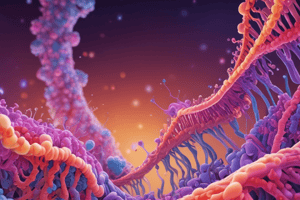Podcast
Questions and Answers
What is the normal CFTR description?
What is the normal CFTR description?
CFTR protein is created, moves to cell surface and allows transfer of chloride and water.
What is the Class I mutation description?
What is the Class I mutation description?
- CFTR protein is created in insufficient quantities
- CFTR protein is created but misfolds
- CFTR protein is functional but the channel gate does not open
- No functional CFTR is created (correct)
What kinds of mutations are Class I mutations?
What kinds of mutations are Class I mutations?
Nonsense, splicing, deletion mutations.
What is the Class II mutation description?
What is the Class II mutation description?
Which percentage of people carry Class II mutations?
Which percentage of people carry Class II mutations?
What is the common mutation for Class III?
What is the common mutation for Class III?
What happens in Class IV mutations?
What happens in Class IV mutations?
What is the description for Class V mutations?
What is the description for Class V mutations?
What potential therapy is suggested for Class I mutations?
What potential therapy is suggested for Class I mutations?
Which drugs help in the treatment of Class II mutations?
Which drugs help in the treatment of Class II mutations?
What do potentiators do for classes III, IV, and V?
What do potentiators do for classes III, IV, and V?
What does the CFTR protein control?
What does the CFTR protein control?
How many copies of the CFTR gene does each human have?
How many copies of the CFTR gene does each human have?
How many mutated copies are needed to have CF?
How many mutated copies are needed to have CF?
What do gene editing techniques aim to do?
What do gene editing techniques aim to do?
What do gene replacement strategies aim to do?
What do gene replacement strategies aim to do?
What is the goal of RNA therapies?
What is the goal of RNA therapies?
What do read-through compounds aim to do?
What do read-through compounds aim to do?
What do correctors do in the context of CFTR mutations?
What do correctors do in the context of CFTR mutations?
What do potentiators do?
What do potentiators do?
Flashcards are hidden until you start studying
Study Notes
CFTR Overview
- CFTR protein facilitates chloride and water transport, crucial for maintaining salt and water balance in lungs and other tissues.
- Each human has two copies of the CFTR gene; both must be mutated for cystic fibrosis (CF) to develop.
CFTR Mutation Classes
- Class I: No functional CFTR produced; accounts for 22% of mutations. Common mutation: G542X. Known as "production mutations."
- Class II: CFTR protein is created but misfolded, preventing it from reaching the cell surface. Occurs in 88% of cases. Common mutation: F508del. Referred to as "processing mutations."
- Class III: Functional CFTR protein reaches the surface, but the channel gate fails to open correctly. Represents 6% of mutations. Common mutation: G551D. Labeled as "gating mutations."
- Class IV: CFTR protein is present but its channel function is impaired. Also accounts for 6% of mutations. Known as "conduction mutations."
- Class V: Normal CFTR is produced but in insufficient quantities.
Potential Therapies
- Class I Therapies: Read-through compounds can help produce full-length CFTR, bypassing nonsense mutations.
- Class II Therapies: Correctors like lumacaftor or tezacaftor aid in proper folding of CFTR, allowing it to reach the cell surface effectively.
- Classes III, IV, and V Therapies: Potentiators, such as ivacaftor, facilitate the opening of CFTR channels and improve function of both defective and normal CFTR.
Gene Editing and RNA Therapies
- Gene Editing: Aims to repair the genetic defect in CF gene DNA directly.
- Gene Replacement: Seeks to supply a correct version of the CFTR gene.
- RNA Therapies: Focus on correcting defective RNA instructions or providing normal RNA to cells.
- Read-Through Compounds: Enable the synthesis of full-length CFTR even with stop mutations (Class I).
- Correctors: Support proper folding of defective CFTR for effective surface transport (Class II).
- Potentiators: Enhance channel opening at the surface, boosting chloride transport (Classes III, IV, and V).
Important Considerations
- Understanding different mutation classes assists in identifying targeted treatment approaches for cystic fibrosis.
- The variety of therapeutic strategies reflects the complexity of CFTR mutations and the variability in patient presentations.
Studying That Suits You
Use AI to generate personalized quizzes and flashcards to suit your learning preferences.



